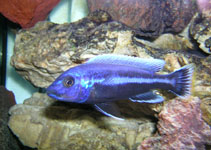| Diagnosis: |
Dorsal spines (total): 17-18; Dorsal soft rays (total): 8-9; Anal spines: 3-3; Anal soft rays: 7-8. Diagnosis: Females and subadults of Melanochromis chipokae are distinguished from those of all other Melanochromis species by a yellow ground colour and a black submarginal band in the dorsal and anal fins (Ref. 89864). Male M. chipokae in breeding colour have a blue occipital region, a dark-blue/black body with two wide, light-blue horizontal stripes, and a blue dorsal fin with a wide white margin; they differ from males of most Melanochromis species with a similar colour pattern, except M. robustus and M. heterochromis, by the blue occipital region that is black or gray in M. melanopterus, M. vermivorus, M. simulans, M. loriae, M. robustus and M. mossambiquensis (Ref. 89864). Melanochromis chipokae males and females differ from M. robustus by a narrower interorbital width, 17.5-23.3% of head length vas. 26.1-29.6%, and from M. heterochromis by a longer lower jaw, 36.5-38.9% of head length vs. 29.3-34.6% (Ref. 89864).
Description: Spindle-shaped species with greatest body depth at approximately base of fourth dorsal spine; dorsal body profile below dorsal fin slightly convex anteriorly and with downward curve along base of soft dorsal fin to caudal peduncle; ventral body profile with gradual upward curve to anal fin and with more acute curve to caudal peduncle; dorsal head profile straight between snout tip and interorbital, at about 30-35° angle relative to body axis; profile rounded between interorbital and dorsal fin origin (Ref. 89864). Horizontal eye diameter much larger than preorbital depth; 1/2 to 3/4 of eye, along horizontal axis, located in anterior half of head; snout long with isognathous jaws; teeth on lower jaw in 3-5 rows with anteriormost teeth of outer row large, unequally bicuspid in adult males and almost equally bicuspid in females; lateral teeth unicuspid; inner row teeth small, unequally tricuspid to unicuspid in posterior rows (Ref. 89864). Dorsal fin with XVII-XVIII spines and 8-9 soft rays; anal fin with III spines and 7-8 soft rays; first 3 or 4 dorsal spines becoming gradually longer posteriorly with first spine about 1/2 length of third; last 14 spines becoming slightly longer posteriorly with last spine longest; soft dorsal with rounded or subacuminate tip, fifth ray longest, extending almost to base of caudal fin in females and to approximately 1/4 length of caudal fin in males; anal spines becoming progressively longer posteriorly; fourth or fifth ray longest, extending to approximately base of caudal fin in males, but not in females; caudal fin subtruncate to emarginate; pelvic fin not reaching anal fin; pectoral fin rounded, paddle-shaped, short, posterior tip extending to vertical line through base of 10th or 11th dorsal spine (Ref. 89864). Flank scales large, ctenoid; abrupt transition to small scales on breast; cheek with 4-5 rows of small scales; proximal 75-90% of caudal fin covered with tiny scales, none on dorsal or anal fin (Ref. 89864).
Colouration: Breeding males: head below orbit dark blue/black, two light-blue interorbital bands, upper interorbital band continuous with dorso-lateral stripe on flank; occipital region blue; body dark blue/black with solid light-blue/white midlateral stripe 2-3 scales wide and solid light-blue dorso-lateral stripe; area between dorso-lateral stripe and base of dorsal fin blue to dark blue; caudal peduncle dark blue/black with light-blue midlateral stripe; belly and breast dark blue/black; dorsal fin blue with broad white/light-blue margin and white lappets; proximal 1/2 to 3/4 soft-rayed dorsal with black membranes and light-blue rays, remaining, distal part light blue; proximal 1/2 to 3/4 caudal fin dark blue/black with large light-blue spot at base as continuation of mid-lateral stripe; distal 1/4 to 1/2 of caudal fin with light-blue rays and wide yellow margin; anal fin black, with light-blue ventral margin and 1-3 orange/yellow ocelli on light-blue marginal region; pelvic fin black with light-blue anterior edge; pectoral fin with dark-blue/black rays and clear membranes (Ref. 89864). Females: head yellow/gray with two black interorbital bars on snout and nape; cheek and throat cream/white; two black interorbital bars, and less distinct lachrymal stripe between the eye and corner of mouth; occipital region with irregular black markings blending with dorso-lateral stripe; wide black band extending from posterior edge of eye and continuing as midlateral stripe on flank; body lemon yellow to gray-yellow; two broad black stripes on flank, midlateral stripe solid, about 3 scales wide, with feathered margins; dorso-lateral stripe wide, merging with base of dorsal fin; dorsal and anal fins lemon yellow with black submarginal band; caudal fin gray/yellow with large black spot at base, wide lemon-yellow margin, and black spots and streaks throughout; pelvic fin gray/yellow with white/light-blue anterior margin and wide black submarginal band; pectoral fin with yellow rays and clear membranes (Ref. 89864). |

